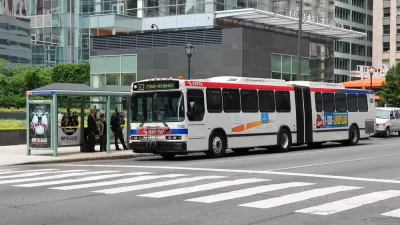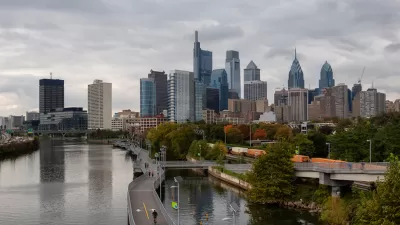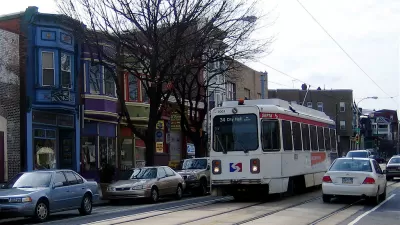The High Line is a famous example of urban revitalization, but a useful commuter path it is not. Can a similar proposal in Philadelphia offer the benefits of beautification and mobility?

Malcom Burnley revisits the idea of a linear park like the one proposed for the Reading Viaduct in Philadelphia as a benefit to the mobility of the city, not just another example of urban beautification similar to the example set by the High Line in New York City.
Burnley tours the proposed route with Michael Garden, boardmember with the Friends of the Rail Park, the driving force behind the proposed project. Before discussing its potential mobility benefits of the park, Brunley provides this summary of the long-term plans for the park:
In Phase 1, the elevated rail line would be repurposed, much like the High Line. In Phase 2, a 1.75-mile stretch of underground tunnels and dug-out space known as the City Branch (or, colloquially in transit circles, as “The Cut”) would be redone into a green corridor with paved throughways that might rival the cool factor of the Schuylkill Banks.
Distinguishing the Viaduct Rail Park proposal from the often-clogged High Line, "Garden envisions both the above-ground and below-ground portions of project as having ample room for bike lanes, running/pedestrian lanes, recreational space and even retail kiosks with coffee (and maybe some of those bougie popsicles)."
Burnley's conclusion after considering Garden's points:
I’d argue that the proposed rail park would not be transformative in the way that, say, stripping parking minimums from the zoning code or creating rapid transit on Roosevelt Boulevard would be. In that sense, maybe it’s a luxury transportation improvement. Nonetheless, it’s one that the city deserves.
The article follows an earlier article by Brunley listing 20 "smart transportation ideas" underway in Philadelphia. At the time, he left the Reading Viaduct off the list. An October study by the Delaware Valley Regional Planning Commission [pdf] concluded the potentially building a bus-only route along the path of the viaduct would be too expensive.
FULL STORY: Reading Viaduct Park Would Make Getting Around Philly Easier

Planetizen Federal Action Tracker
A weekly monitor of how Trump’s orders and actions are impacting planners and planning in America.

Maui's Vacation Rental Debate Turns Ugly
Verbal attacks, misinformation campaigns and fistfights plague a high-stakes debate to convert thousands of vacation rentals into long-term housing.

San Francisco Suspends Traffic Calming Amidst Record Deaths
Citing “a challenging fiscal landscape,” the city will cease the program on the heels of 42 traffic deaths, including 24 pedestrians.

Defunct Pittsburgh Power Plant to Become Residential Tower
A decommissioned steam heat plant will be redeveloped into almost 100 affordable housing units.

Trump Prompts Restructuring of Transportation Research Board in “Unprecedented Overreach”
The TRB has eliminated more than half of its committees including those focused on climate, equity, and cities.

Amtrak Rolls Out New Orleans to Alabama “Mardi Gras” Train
The new service will operate morning and evening departures between Mobile and New Orleans.
Urban Design for Planners 1: Software Tools
This six-course series explores essential urban design concepts using open source software and equips planners with the tools they need to participate fully in the urban design process.
Planning for Universal Design
Learn the tools for implementing Universal Design in planning regulations.
Heyer Gruel & Associates PA
JM Goldson LLC
Custer County Colorado
City of Camden Redevelopment Agency
City of Astoria
Transportation Research & Education Center (TREC) at Portland State University
Jefferson Parish Government
Camden Redevelopment Agency
City of Claremont





























